We can find the IP in the project "P1" at the server entry in the Hetzner Cloud environment.
Under project P1 our server is listed. There you will find the IP. Since we will need it again and again, we should note it down to not have to navigate here every time.

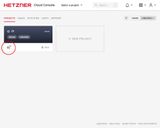
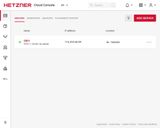
We now switch to Hetzner's DNS administration, where we store the entries. By the way, this page is only available in English.
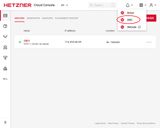
First we create a new zone with "add new zone". In the field "your DNS zone" we write the newly registered domain name. From the three options we select "import zone file". This will allow us to edit the zone file directly. We could also click this together with the first option using form fields, but I find it clearer in the original. Besides, it is certainly instructive to have seen the DNS syntax once. With a click on "continue" we see a standard template. We will add to it.
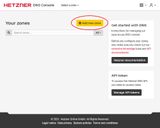
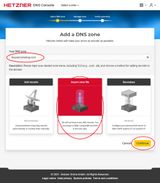
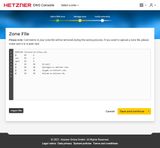
The default entries are the following:
$ORIGIN linuxserversetup.com.
@ IN A
www IN A
mail IN A
@ IN MX 10 mail
@ IN NS hydrogen.ns.hetzner.com.
@ IN NS oxygen.ns.hetzner.com.
@ IN NS helium.ns.hetzner.de.
Short explanation
The $ORIGIN statement defines the zone name. The @ character is a placeholder, for $ORIGIN. The A record is thus assigned linuxserversetup.com. as well as the subdomains www and mail. The MX (Mail Exchange) record is for the mail server and is set with priority 10. If there are multiple mail servers, the lower number would be preferred. The three name servers are listed with NS. The zone class IN stands for "Internet". One more note about the dot . at the end of the domain: it is important because it is part of a Fully Qualified Domain Name (FQDN).
Our additions
We complete the zone file with our server IP, the SOA Record mentioned earlier, and one more subdomain "dev". The date format of the SOA serial is according to ISO 8601: YYYY-MM-DD. The number of changes is represented by the last two digits. This counter starts at 1.
The final zone file
Our DNS file should finally have these entries. My server IP is 116.203.69.89, you have to enter yours here of course:
$ORIGIN linuxserversetup.com.
; SOA Records
$TTL 86400
@ IN SOA hydrogen.ns.hetzner.com. dns.hetzner.com. (
2021123101 ; serial
86400 ; refresh
10800 ; retry
3600000 ; expire
3600 ; negatives caching
)
; NS Records
@ IN NS hydrogen.ns.hetzner.com.
@ IN NS oxygen.ns.hetzner.com.
@ IN NS helium.ns.hetzner.de.
; MX Records
@ IN MX 10 mail
; A Records
@ IN A 116.203.69.89
mail IN A 116.203.69.89
www IN A 116.203.69.89
dev IN A 116.203.69.89
With the dev record we can later create a subdomain (dev.linuxserversetup.com) as a development site and assign it its own TLS certificate. A note about the mail record: The mail.linuxserversetup.com subdomain is important for the mail exchange server, so most web servers will need it as well.
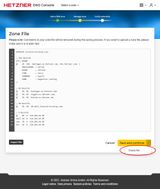
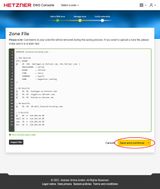
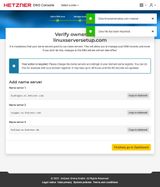
With "check file" we check the file. If everything is ok, we save it and then we have to be patient. Usually it takes only a few hours until the whole globe can resolve our domain to our server IP.
We can ignore the hint that we have to adjust the nameservers, because we have already stored them during the domain registration.
Other possible record types
There are various other record types that we don't need for now, but might come into use later. For example:
- AAAA-Record: Also called "quad-A", refers to IPv6 addresses.
- CNAME-Record: Alias for other DNS names.
- PTR-Record: Stands for "pointer" and is for DNS inverse queries (reverse DNS lookup).
- TXT-Record: Allows an administrator to write text into the DNS record. Mostly these are SPF (Sender Policy Framework) entries, for example as spam protection, or to authenticate domain ownership to services like Google Console.